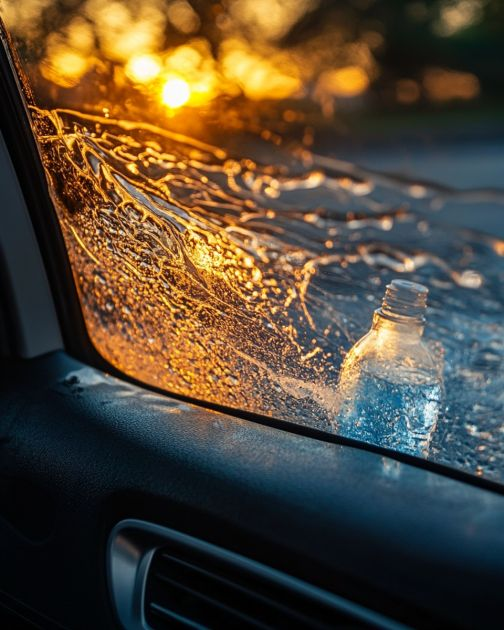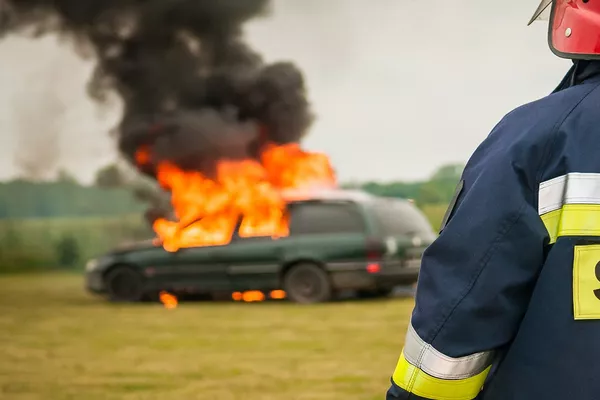Keeping a water bottle in your car seems like a no-brainer, especially on hot days when hydration is key. However, firefighters across the country are issuing a surprising warning: leaving water bottles in your car can create a hidden fire hazard. While it may sound far-fetched, this everyday habit has caused real damage, and understanding the risks is crucial to keeping you safe.
The Hidden Danger of Water Bottles in Cars

At first glance, a simple plastic water bottle doesn’t seem like it could cause much harm. However, under the right conditions, that harmless bottle can act as a powerful lens, magnifying sunlight to a dangerous degree. This risk is heightened when the bottle is left in a car, where sunlight streaming through the windows can heat surfaces to alarming temperatures.
How Water Bottles Become a Fire Hazard
Here’s how it works: when sunlight passes through a clear, water-filled plastic bottle, the bottle acts like a magnifying glass. It concentrates the light into a single, focused beam. If that beam lands on a flammable material—like car upholstery, paper, or plastic—it can ignite the surface.
This effect is similar to using a magnifying glass to start a fire outdoors. The materials inside a car, particularly during the summer months, can reach temperatures high enough to catch fire within minutes.
Real-Life Incidents That Prove the Risk
You might wonder if this really happens. Unfortunately, it does.
In 2017, a power company worker in Idaho experienced this firsthand. He left a water bottle on the seat of his truck while parked in direct sunlight. Moments later, he noticed smoke coming from his seat. The bottle had focused sunlight onto the upholstery, causing it to smolder. Luckily, he caught it before the situation escalated.
Other similar reports have emerged, highlighting how easily a water bottle can become an unintentional fire starter. These incidents, while rare, underscore the importance of taking precautions.
The Science Behind the Phenomenon
From a scientific perspective, this fire hazard is easy to explain. A water-filled plastic bottle behaves like a convex lens, focusing sunlight into a concentrated beam. This focused light dramatically increases the temperature at the point of contact.
The exact risk depends on factors like the angle of sunlight, the bottle’s position, and how long it’s exposed. Under optimal conditions, the temperature can spike high enough to ignite flammable materials within seconds.
Simple Tips to Prevent Water Bottle Fires
Preventing this hazard doesn’t require drastic measures—just a little awareness and some simple precautions.
- Avoid Leaving Bottles in Direct Sunlight: Never leave a plastic water bottle on your car’s seats, dashboard, or anywhere exposed to sunlight.
- Use Non-Transparent Bottles: Opt for reusable water bottles made of stainless steel or opaque materials. These don’t allow sunlight to pass through, eliminating the risk of magnification.
- Store Bottles in Safe Places: If you need to keep water in your car, place it in the trunk, under the seat, or in a shaded area where it won’t be exposed to direct sunlight.
- Keep Flammable Materials Out of the Car: Reduce the risk by removing items like paper, napkins, or plastic bags that could easily ignite.
What to Do If You Spot a Fire Hazard in Your Car

If you notice a water bottle sitting in a sunny spot in your car, move it immediately to a shaded area or take it out of the vehicle. Regularly inspect your car for potential fire hazards, especially during hot weather.
In the unfortunate event that a fire starts:
- Evacuate Immediately: Prioritize your safety by leaving the vehicle.
- Call Emergency Services: Contact firefighters to handle the situation professionally.
- Don’t Attempt to Extinguish the Fire: Car fires can spread quickly. It’s safer to leave it to the experts.
Why Firefighters Are Raising Awareness
Firefighters aren’t issuing these warnings to alarm you unnecessarily. Their goal is to raise awareness about a risk many people haven’t considered. A simple habit like leaving a water bottle in the car can have unforeseen consequences, especially in the scorching heat of summer.
Conclusion
While the idea of a water bottle starting a fire may sound like something out of a science experiment, real-life cases prove it’s a legitimate concern. By taking simple precautions—like storing bottles in shaded areas or using non-transparent alternatives—you can reduce the risk and keep your car safe.
Stay vigilant, stay informed, and make small changes to protect yourself and your passengers. It’s always better to be proactive than to face the unexpected consequences of a preventable fire hazard.Firefighters are warning folks


